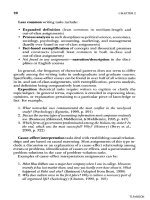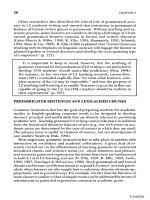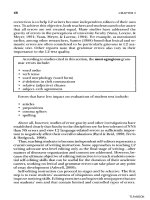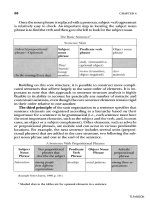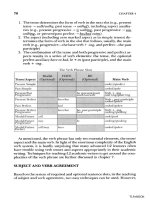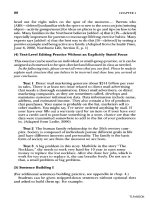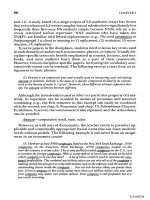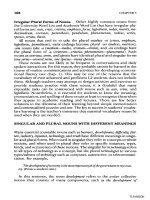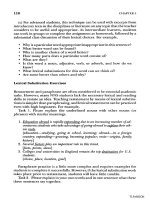Tài liệu Teaching academic ESL writing part 4 ppt
Bạn đang xem bản rút gọn của tài liệu. Xem và tải ngay bản đầy đủ của tài liệu tại đây (768.34 KB, 10 trang )
18
CHAPTERS
those written discourse genres
and
formats common
in the
academy
in
English-speaking
environments.
WRITING
REQUIREMENTS
IN THE
UNIVERSITY
Undergraduate students
in
U.S. colleges
and
universities
are
required
to
take
general education courses
in
such disciplines
as the
sciences, history,
philosophy, psychology,
and
sociology prior
to
their studies
in
their chosen
majors.
One
implication
of
this
structure
in
U.S.
college
education
is
that
the
greatest demand
on
students' language
skills
occurs during
the
first
2
years
of
their academic careers, when they
are
expected
to
read
large
amounts
of
diverse types academic text, write many short
and
long assign-
ments,
and
take
numerous
tests
and
exams.
In the
academy
in
English-speaking countries,
the
purpose
of
written
as-
signments
and of
examinations
and
testing
is to
require students
to
display
their knowledge
and
familiarity
with
the
course material. Examinations
vary
in
types
and
formats,
ranging
from multiple-choice tests
to
lengthy
term papers, including essay tests
and
short essay-like responses. Outside
multiple-choice
tests,
a
great deal
of
writing
is
expected
in
most undergrad-
uate courses,
and it is not
unusual
for
students
to
have
to
produce
up to a
dozen written assignments
per
term (Horowitz, 1986a). Even some multi-
ple-choice tests—such
as the
TOEFL, ACT,
or
SAT—incorporate
an
essay
component designed
to
measure test takers' writing proficiencies.
It
is
important
to
note that practically
all
writing assignments necessi-
tate more than
one
writing task, such
as
exposition
in the
introduction, fol-
lowed
by
cause/effect
or
comparison/contrast rhetorical structures,
and
possibly
back
to
exposition
in the
conclusion.
For
instance, most types
of
writing
assignments
can
include summaries
of
published works
or
synthe-
ses
of
multiple sources
of
information
or
data.
In
this case,
the
writing
tasks
would include synthesis
(or
analysis)
of
information, paraphrasing,
and
restatement
skills.
Beginning
in the
early 1980s, several studies undertook
to
investigate
the
types
of
writing assignments
and
tasks required
of
undergraduate
and
graduate students
in
academic mainstream courses
in
various disciplines,
such
as the
natural sciences (e.g., biology, chemistry,
and
physics),
engineer-
ing, business,
and the
humanities including English.
MOST
IMPORTANT CHARACTERISTICS
OF
ACADEMIC
WRITING
A
survey
of 155
undergraduate
and 215
graduate
faculty
in 21
U.S. universi-
ties
specifically
identified
the
essential
NNS
students'
L2
writing
skills
in
courses that
ranged
from
history, psychology, business, chemistry,
and
engi-
neering
(Rosenfeld,
Leung,
&
Oltman, 2001).
The
responses
of
undergrad-
uate
faculty
(Table 2.1) clearly indicate
that
organizing writing
to
convey
TLFeBOOK
STUDENT
WRITING TASKS
AND
WRITTEN
ACADEMIC GENRES
19
TABLE
2.1
Undergraduate
Faculty
Assessments
of
Some Writing Tasks
Mean
Importance
Task
Statement Rating
Organize
writing
to
convey
major
and
supporting ideas. 4.19
Use
relevant reasons
and
examples
to
support 4.09
a
position.
Demonstrate
a
command
of
standard written English, 3.70
including
grammar, phrasing,
effective
sentence
structure,
spelling,
and
punctuation.
Demonstrate
facility
with
a
range
of
vocabulary
3.62
appropriate
to the
topic.
Show
awareness
of
audience needs
and
write 3.33
to a
particular audience
or
reader.
Note.
Mean Importance Rating
on a
scale
of 0 to 5.
major
and
supporting ideas
and
using relevant examples
to
support them
occupy
top
priority
in the
quality
of
academic discourse
1
(ranks
4.19-4.09,
respectively,
out of 5).
In
addition, demonstrating command
of
standard written English, "in-
cluding grammar, phrasing,
effective
sentence structure, spelling,
and
punctuation,"
is
another high-priority requirement (rank 3.70),
as
well
as
demonstrating
"facility
with
a
range
of
vocabulary appropriate
for the
topic" (rank 3.62).
On the
other hand, showing awareness
of
audience
needs
and
writing
to a
particular audience/reader
was not
found
to be as im-
portant
(rank 3.33).
In
addition
to the
faculty,
undergraduate students
ranked
written discourse organization
skills
at
4.18; grammar, phrasing,
and
sentence structure
at
4.15;
and
appropriate vocabulary
at
3.69.
'The teaching
of
academic discourse organization
is
crucially important
in L2
writing
in-
struction,
and a
large number
of
textbooks
are
available that
focus
on
discourse.
It
would
be no
exaggeration
to say
that
the
teaching
of L2
academic
writing
focuses predominantly
on the
fea-
tures
of
discourse organization. However, markedly
few
course books
on L2
writing
for
either
students
or
teacher training address
the
importance
of
text features
in L2
instruction.
As
men-
tioned earlier, however organized
the
information
flow
can be in
student writing,
it may be im-
possible
to
understand without
an
essential
clarity
and
accuracy
of
text.
TLFeBOOK
20
CHAPTER
2
Graduate
faculty
(Table 2.2) identified largely similar priorities
in
student
writing
with regard
to the
importance
of
information/discourse
organization
and
examples (ranks 4.46
and
4.34, respectively), grammar, phrasing,
and
sentence
structure (rank 4.06),
and
appropriate
vocabulary (3.74).
On
the
other hand, graduate students ranked discourse organization
and
exemplification
at
4.32
and
3.96, respectively; grammar, phrasing,
and
sentence structure
at
3.83;
and
vocabulary 3.56 (i.e., below
the
importance
rankings assigned
by
graduate
faculty
in
practically
all
categories).
In a
separate subset
of
survey
items, both undergraduate
and
graduate
fac-
ulty
also specified
the
specific
writing
skills
that
in
their experiences deter-
mined
the
success
of
NNS
students
in
their
courses.
For
undergraduate
faculty,
the top
three
L2
writing
skills
included
(in
declining
order
of
importance):
•
discourse
and
information organization (2.40
out of 3)
•
standard written English (i.e., grammar, phrasing,
and
sentence
structure; 2.35)
•
vocabulary
(2.26).
Among graduate
faculty,
the top
three
skills
essential
for
success
in
aca-
demic courses consisted
of:
•
information/discourse organization (2.49
out of 3)
TABLE
2.2
Graduate
Faculty
Assessments
of
Some Writing Tasks
Mean
Importance
Task
Statement Rating
Organize writing
to
convey
major
and
supporting 4.46
ideas.
Use
relevant reasons
and
examples
to
support 4.34
a
position.
Demonstrate
a
command
of
standard written 4.06
English,
including grammar, phrasing,
effective
sentence structure, spelling,
and
punctuation.
Demonstrate
facility
with
a
range
of
vocabulary
3.74
appropriate
to the
topic.
Show
awareness
of
audience needs
and
write 3.62
to
a
particular audience
or
reader.
Note.
Mean
Importance
Rating
on a
scale
of 0 to 5.
TLFeBOOK
STUDENT WRITING TASKS
AND
WRITTEN ACADEMIC GENRES
21
•
command
of
standard written English
(2.37)
•
using background knowledge, reference materials,
and
other
re-
sources
to
analyze
and
refine arguments (2.35).
The
employment
of
appropriate vocabulary received
a
ranking
of
2.27.
The
Rosenfeld, Leung,
and
Oltman
(2001)
study demonstrated unam-
biguously
that
L2
grammar
and
vocabulary skills play
a
crucial role
in
stu-
dent
academic success (and obviously survival).
MOST COMMON STUDENT WRITTEN ACADEMIC
ASSIGNMENTS
AND
TASKS
The
most comprehensive study
of
academic writing tasks
was
carried
out by
the
Educational Testing Service (Hale
et
al., 1996), which surveyed eight
large comprehensive universities
in the
United States.
The
information dis-
cussed
in
this investigation
is
summarized next.
Major
Writing Assignments
Major
academic essays typically have
a
specified length
of 5 to 10 or
more
than
10
pages.
These
papers predominantly take
the
forms
of
out-of-class
assignments
and are
required
far
more frequently
in
humanities courses
such
as
psychology, economics, history,
and
English than
in the
sciences,
en-
gineering,
or
computer science. Most
of
these projects also necessitate
li-
brary research
and
syntheses
of
literature
and
relevant information
from
a
variety
of
sources. According
to the
Hale
et al.
(1996)
findings,
undergradu-
ate
courses
in the
sciences
and
engineering rarely expect students
to
write
papers
as
long
as 5 to 10
pages,
and
most
of
these types
of
essays
are ex-
pected
in
English department courses.
Medium-Length Essays
and
Short Written Tasks
Medium-length essays between
1 and 5
pages
are
required
as
in-class
and
out-of-class
assignments
in
practically
all
disciplines, with
the
exceptions
of
undergraduate courses
in
physics, mathematics,
and
engineering.
In
social
science
and
humanities studies, they
are
expected
in a
majority
of
under-
graduate courses. Similarly, short written assignments
of
about
0.5 to 1.5
pages represent course components
in
approximately half
of all
undergrad-
uate courses, including physics, math,
and
engineering,
and 94% of
English
courses (Hale
et
al., 1996).
These
essays
are
assigned both
in and out of
class
in
undergraduate
and
graduate studies alike. Among these assignments,
li-
brary research reports, laboratory
or
experiment
reports
with
or
without
in-
terpretation,
and
book reviews represent
the
most common types
of
writing.
TLFeBOOK
22
CHAPTER
2
Short writing tasks (also called
expanded answers)
found
in
many written
in-class
and
out-of-class exams, laboratory reports, case studies, annota-
tions
of
literature,
and
computer program documentation assignments
constitute
the
most common type
of
writing across
all
disciplines
and
courses.
Furthermore, short writing assignments
are
significantly
more
common
in
undergraduate than graduate courses
and in
in-class than out-
of-class
assignments.
English Composition Writing Tasks
English composition instruction often provides
the
model
for
teaching writ-
ing in
EAPs. According
to the
Hale
et al.
(1996) study, short writing tasks
are
far
less common
in
English than
in
social
or
natural sciences (29%
of all
in-class
assignments
vs. 53% and
79%, respectively).
On the
other hand,
out-of-class
essays
are
required
in 94% of all
English courses,
for
example,
compared with
53% in
social
and 47% in
natural sciences. Among
the as-
signment types, summaries
and
unstructured writing genre defined
as
free
writing,
journal entries,
or
notes,
all
which consist
of
writing down one's
thoughts
and
experiences,
are
found almost exclusively
in
English courses,
as
well
as
twice
as
many assigned library research papers
as in
other disci-
plines.
Major
papers
of 5 to 10
pages
in
length
are
assigned
in 41% of
Eng-
lish
courses
and
only rarely
in
social science courses. Similarly,
1- to
5-page
essays
are
required
in 82% of
English courses versus
39% of
those
in
social
sciences
and 21% in
physical/natural sciences.
FEATURES
OF
ACADEMIC
GENRE
AND
TEXT
Research into various types
of
discourse
and
text (Biber, 1988; Biber,
Johansson, Leech, Conrad,
&
Finegan, 1999; Swales, 1990a) showed explic-
itly
and
clearly that academic discourse
and
text
are
constructed
differently
than
other
types
of
text, such
as
fiction, news
reportage,
or
personal corre-
spondence.
In
fact,
Swales (1990a) identified what
he
called "the academic
discourse community"
(p. 5),
which prescribes somewhat rigid forms
of
dis-
course construction
and
organization combined with similarly
inflexible
ex-
pectations
of
vocabulary
and
grammar uses. Biber
et al.
(1999) examined
a
large corpus
of
specific
microfeatures
of
texts
in
diverse spoken
and
written
genres,
and
their findings
are
described
in a
1,200-page volume.
Their
analysis
includes
the
cross-genre uses
of
nouns, determiners, pronouns,
verb tenses,
and
semantic classes
of
verbs, adjectives, adverbs,
and
clauses.
Textual uses
of
practically
all
features indicate that written academic text
is
markedly
distinct from many other types
of
texts, such
as
personal narra-
tive,
conversation,
and
even
academic
lectures.
Other corpus studies investigated frequencies
of use of
various lexical
and
syntactic features employed
in
academic
and
other types
of
text
to
eluci-
TLFeBOOK
STUDENT
WRITING
TASKS
AND
WRITTEN
ACADEMIC GENRES
23
date
the
differences between
the
academic
and
other
types
of
written gen-
res.
For
example, these examinations
focus
on
various hedges, modal verbs,
epistemic
adjectives, adverbs,
and
nouns (Collins, 1991; Hoye, 1997;
Hyland, 1998),
as
well
as
classes
of
collocations, idioms, synonyms, adverb
clauses,
and
text-referential cohesion (Partington, 1996).
These
studies
ex-
panded
the
current knowledge base regarding
specific
structures
and
lexi-
cal
features
of
written academic text,
as
well
as
other common features
of
text such
as
noun
and
prepositional phrases, stock phrases,
and
collocations
(Kennedy,
1991;
Kjellmer,
1991; Renouf
&
Sinclair, 1991).
For
instance, analyses
of
large corpora have
led to the
development
of
pattern
grammar
to
identify combinations
of
words
that
occur
relatively fre-
quently
in
academic texts
and
that
may be
dependent
on a
particular word
choice
to
convey clear
and
definable meaning (Hunston
&
Francis, 2000).
Because
of
great strides made
in
corpus analyses
in the
past
few
decades,
to-
day
much more
is
known about frequent patterns
of
verb, noun,
and
adjec-
tive
uses
and
variations
in
their meanings,
as
well
as the
syntactic
and
lexical
contexts
in
which particular lexical
and
syntactic features occur.
Although findings
of
text
and
corpus analyses
of the
written academic
genre
may not be
directly applicable
to
classroom instruction
and
studies
of
student texts, they provide insight into discourse
and
text conventions
of
published academic
and
other types
of
texts. Furthermore, they often help
explain
how
written academic prose
is
constructed and,
by
implication,
can
inform
writing instruction
and
pedagogy.
An
additional benefit
of
corpus
studies
is
that they shed light
on how
enormously complex
and
frequently
lexicalized
the
uses
of
language
and
text
in the
academic genre actually are.
TEACHING
ACADEMIC
TEXT
FEATURES
Several researchers have identified English composition essays
and the
pedagogical essays (Johns, 1997) ubiquitous
in
English
for
Academic Pur-
poses
(EAPs)
programs
to be
dramatically
different
from those students
are
required
to
write
in the
disciplines. Among other researchers, Horowitz
(1986a)
identified some
of the
writing tasks
in
undergraduate humanities
courses.
According
to his
findings, these included:
•
summary/reaction
to a
journal article
or
reading
•
annotated bibliography
in
such disciplines
as
biology, lab,
and ex-
periment reports
•
connections between theory
and
data
•
synthesis
of
multiple literature sources
•
various research projects
Horowitz
further noted that these assignments
do not
include invention
and
personal discovery
and
"the academic writer's task
is not to
create per-
TLFeBOOK
24
CHAPTER
2
sonal meaning
but to
find,
organize,
and
present data according
to
fairly
ex-
plicit instructions"
(p.
452). According
to the
author, sentence-level
grammar,
use of
discourse markers,
and
clarity
of
academic text remain "vi-
tal"
(p.
454)
in the
teaching
of
academically
bound
NNS
students.
In the
1980s, several studies endeavored
to
learn about
the
reactions
of
faculty
to
particular features
of NNS
students' text (Johns, 1981; Ostler,
1980; Santos, 1988; Vann, Lorenz,
&
Meyer, 1991; Vann,
Meyer,
&
Lorenz,
1984).
Most professors
in the
disciplines
are not
well versed
in the
complex-
ities
of ESL
instruction
or L2
learning
and
acquisition. Nonetheless,
their
perceptions
of
text quality
are
important because they
are the
ones
who
grade
students' assignments. According
to the
results
of
these
studies,
the
employment
of
syntactic,
lexical,
and
discourse features
of
text
and
errors
in
the
uses
of
these features have
an
influential
effect
on the
perceived quality
of
students' text. Although sentence-
and
phrase-level errors
are
often
seen
in
relative rather than absolute terms,
the
problems
in
students' uses
of
verb
tenses, word order, subordinate clauses, passive voice,
and
impersonal con-
structions
have been found
to
obscure
the
text's meaning.
In the
view
of
fac-
ulty
in
various disciplines, such
as
physical
and
natural sciences, human-
ities,
business,
and the
arts, accuracy
in the
uses
of
these
and
other syntactic
and
lexical features
is
very important and,
in
most cases, syntactic
and
lexi-
cal
errors
result
in
lower assignment grades.
When thinking about
the
importance
of
accuracy
in the
academic writing
of
NNS
students, many
ESL and EAP
teachers believe that syntactic
and
lex-
ical
errors
in L2
texts
are not
particularly damaging because
NS
writers also
make
numerous mistakes
in
their texts. However, several studies have found
that
faculty
in the
disciplines have
a far
more critical
view
of ESL
errors than
those
of NSs
(Santos, 1988; Vann
et
al., 1984, 1991). Although
the
indica-
tions
of
error
gravity
vary
across disciplines
and
even
vary
according
to the
age of
faculty,
the
conclusions
in all
investigations largely remain similar:
ESL
errors
in
students' texts
are
costly
in
terms
of
grades
and
overall evalua-
tions
of
work quality.
To
determine whether
the
needs
of
academically bound
NNS
learners
were adequately addressed
in EAP
writing instruction, Leki
and
Carson
(1997)
interviewed
a
large group
of
students
who
began their
ESL
training
and
then
continued
their
studies
in
various disciplines, such
as
engineering,
biology,
business, communications,
and
social work.
The
students
reported
great
differences
between
the
demands
of
writing
in EAP
classes
and
those
in
the
disciplines. Among other important considerations, many students
identified
shortfalls
in
their vocabulary repertoire
and a
lack
of
familiarity
with
the dry
academic textual style. Most important,
the
students spoke
about
the
fact
that
EAP
writing instruction represents what Leki
and
Carson
called
"non-text-responsible
writing"
(p.
63), whereas
in the
disciplines stu-
dents
are
held accountable
for the
context
of the
text they read
and the
con-
tent
and
accuracy
of the
text they produce.
The
authors concluded that what
TLFeBOOK
STUDENT
WRITING
TASKS
AND
WRITTEN
ACADEMIC GENRES
25
is
valued
in
writing classes that emphasize personal growth
and
experience
is
distinct
from
that necessary
in
academic writing
in the
disciplines. They
further
stated that
EAP
writing
instruction
has the
responsibility
for
prepar-
ing
students
for
"real" academic courses because without adequate expo-
sure
to the
demands
of
academic writing students
are
essentially
left
to
their
own
devices once their
EAP
training
is
completed.
Johns (1997) explained that
the
narrow
focus
of
writing instruction
in
EAPs
and its
focus
on
experiential essays
is
often based
on the
principle that,
"if
you can
write
[or
read]
an
essay,
you can
write
[or
read] anything"
(p.
122).
She
pointed
out
that
in
mainstream courses
the
expectations
and
grading
of
writing
are
different
from
those
of
ESL/EAP
faculty.
In
fact
she
commented that when
NNS
students
are
exposed
to
largely
one
type
of
writ-
ing
task, they come
to
believe that "this
is the
only
way to
write." Such lim-
ited experience
with
writing actually does students
a
disservice
and
causes
problems
in
their academic
and
professional careers.
Like
Horowitz,
Johns
emphasized
the
importance
of
text
in
students'
ac-
ademic writing.
She
emphasized that
faculty
often complain that students
do not use
vocabulary
and
data with care. However,
in her
view,
because per-
sonal
essays
are
highly valued
in ESL and EAP
writing instruction
and be-
cause many instructional readings
are in
story form and/or
simplified
specifically
for NNS
readers, students
are not
exposed
to the
precision
often
expected
in
much
of the
academic prose. Furthermore, considerations
of
academic
objectivity
often conveyed
by
lexical
and
syntactic means, such
as
uses
of
personal pronouns
and
passive voice,
are in
conflict
with those fea-
tures
of
text encouraged
in
personal essays. Johns emphasized that formal
academic register requires writers
to be
guarded
and
personally
and
emo-
tionally
removed
from
the
text.
She
underscored that
the
hedged
and de-
personalized register
of
academic text
is
rarely addressed
in
ESL/EAP
writing
instruction,
but
should
be if
students
are to
attain
the
proficiency
necessary
for
their success
in
mainstream academic courses.
In
other studies, Dudley-Evans
and St.
John
(1998) also stated that
"the process approach
[to
teaching
L2
writing], although extremely valu-
able
in
helping students organize
and
plan their writing
has
failed
to
tackle
the
actual texts that students have
to
produce
as
part
of
their aca-
demic
or
professional work"
(p.
117). They also
noted
that
in the
United
States,
most
of
those
who
advocate
a
process approach
see the
teaching
of
generalized strategies
of
planning, writing,
and
revising
as
sufficient
and
believe
that
a
detailed analysis
of
academic texts lies beyond
the job of
the
writing teacher (Raimes, 1993; Zamel, 1983). However, according
to
Dudley-Evans
and St.
John,
the
considerations
of
end-product quality
in
L2
writing
is
important
in
academic
and
professional writing,
and
com-
bining
the
strengths
of
both
the
product-
and
process-oriented
ap-
proaches
to the
teaching
of
writing
can
lead
to
overall improvements
in
L2
writing instruction.
TLFeBOOK
26
CHAPTER
2
THE
NEED
FOR
EXPLICIT INSTRUCTION
IN L2
ACADEMIC
TEXT
In an
important study that surveyed
77
published research reports
on the
effectiveness
of
explicit grammar instruction, Norris
and
Ortega (2000)
normed
the
results
of
investigations
in an
attempt
to
achieve consistency
across various investigative
and
analytical methodologies.
Their
meta-analysis shows
that
in
grammar
learning
focused instruction
of any
sort
is far
more
effective
than
any
type
of
teaching methodology based
on
focused
exposure
to L2
without explicit teaching. They further found that
focused
L2
instruction resulted
in
large language gains over
the
course
of
the
instructional
term
and
that
the
effects
of the
instruction seem
to be du-
rable over time. Furthermore, Norris
and
Ortega explained that explicit
instruction based
on
inductive
or
deductive approaches leads
to
greater
L2
gains than implicit instruction
of any
sort.
Thus,
given that academi-
cally
bound
L2
learners need
to
make substantial
L2
gains
to
begin their
studies,
it
seems clear that
L2
grammar
and
vocabulary should
be
taught
thoroughly
and
intensively.
When
students matriculate
from
ESL/EAP
programs,
the
quality
of
their
writing
and
text
is
evaluated
by
non-ESL specialists
who are
faculty
in the
dis-
ciplines. Furthermore, when students' academic studies
are
completed,
the
accuracy
of
their text production
is
continually appraised
by
subsequent non-
specialists
in
on-the-job writing whenever college-educated
NNSs
write
e-mail,
notes, reports,
and
old-fashioned memos. Considerate, understand-
ing,
and
compassionate
ESL
teachers
who
seek
to
benefit their students have
to
teach
the
skills
and
language features that students must have
to
achieve
their desired professional
and
career goals.
In
fact,
this
is
what
ESL
teachers
are
hired
to do. If
instruction
in the
essential language
skills
is not
provided,
students
are
largely
left
to
their
own
devices when attempting
to
attain
L2
proficiency
needed
for
their
academic
and
professional endeavors.
Much
recent research
has
shown that exposure
to
daily
and
classroom
in-
teractions,
as
well
as
fluency-oriented instruction, does
not
represent
an ef-
fective
pedagogical approach
to
developing syntactic
and
lexical accuracy
(Chang
&
Swales,
1999;
Dudley-Evans
& St.
John,
1998;
Ellis,
2001
Jordan,
1997; Richards,
2002).
Although teachers
in
academic preparatory
and
writing
programs often believe that they
set out to
develop learners' aca-
demic reading
and
writing proficiencies,
in
actuality
few
are
closely
familiar
with
the
types
of
writing assignments
and
tasks
that
NNS
students
need
to
perform
once they complete
their
language training.
For
example,
a
list
in
chapter
5
includes
the
most frequently encountered nouns
in
course mate-
rials
across
all
disciplines
in
college-level general education courses
and
contains
such words
as
ambiguity,
anomaly,
apparatus,
appeal,
and
aristocrat.
In
all
likelihood,
few
practicing
ESL
teachers
in EAP
programs
have
under-
taken
to
teach
the
meanings
of
these words unless they
are
fortuitously
used
in
student reading texts. Fluency development
activities
in
writing that
re-
TLFeBOOK
STUDENT
WRITING TASKS
AND
WRITTEN ACADEMIC GENRES
27
quire students
to
keep
personal
journals
or
carry
out
journal-centered
cor-
respondence with
the
teacher
are not
designed
to
increase learners'
academic vocabulary
or
grammar repertoire, with
its
almost requisite uses
of
passive voice, impersonal construction,
and
complex hedging.
In
fact
such
fluency-based activities encourage
the use of
immediately accessible
lexicon
and
grammar structures without
a
means
of
language gains
and
perpetuate learners' misunderstanding
and
confusion
with
regard
to the
high
degree
of
accuracy
expected
in
formal academic
prose.
A
teacher
of
writing would
do a
disservice
to
academically bound
NNS
students
by not
preparing them
for
academic writing assignments, particu-
larly
those
in the
more common
forms
the
students
are
certain
to
encounter
later
in
their studies. Within these academic assignments
and
tasks, stu-
dents must produce text that
is
academically sophisticated enough
to
dem-
onstrate their understanding
of and
familiarity
with
the
course material.
Yet
few
ESL/EAP programs
undertake
to at
least
expose
their
students
to
vari-
ous
types
of
academic assignments
and
require production
of
written aca-
demic (rather than personal) prose (Chang
&
Swales, 1999; Johns, 1997;
Leki&
Carson, 1997).
TYPES
OF
WRITING TASKS
The
discussion
of
writing
tasks
in
this section relies
on the
findings
of
Hale
et al.
(1996)
to
survey
the
writing requirements
in
eight comprehensive
U.S.
universities. Overall
the
types
of
writing expected
of
undergraduate
and
graduate
students
do not
seem
to
vary greatly with
regard
to the
rhe-
torical
and
discourse patterns they elicit.
Most
assignments combine sev-
eral rhetorical tasks (e.g., exposition
and
analysis
in
business case studies
or
history essays).
The
most common types
of
rhetorical formats found
in
in-class
and
out-of-class
assignments represent
(in
declining
order
of
frequency):
•
Exposition
(short tasks
required
largely
in
introductions
and ex-
planations
of
material
or
content
to
follow,
and
thus
it is a
compo-
nent
of all
assignment types)
•
Cause-effect interpretation
(by far the
most prevalent writing
task,
found
in
over half
of all
writing assignments)
•
Classification
of
events,
facts,
and
developments according
to a
generalized theoretical
or
factual
scheme
•
Comparison/contrast
of
entities,
theories,
methods, analyses,
and
approaches
(in
short assignments)
•
Analysis
of
information/facts
(in
medium-length assignments)
•
Argumentation based
on
facts/research/published literature
(in
medium-length assignments)
TLFeBOOK
